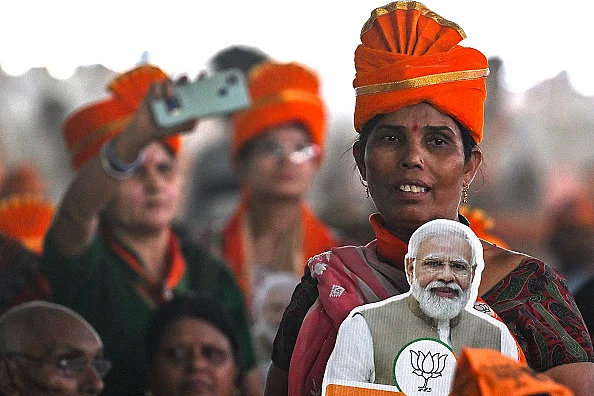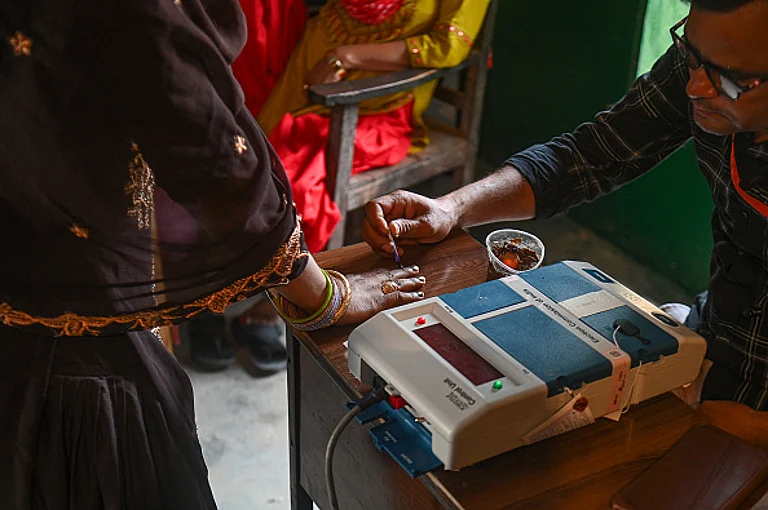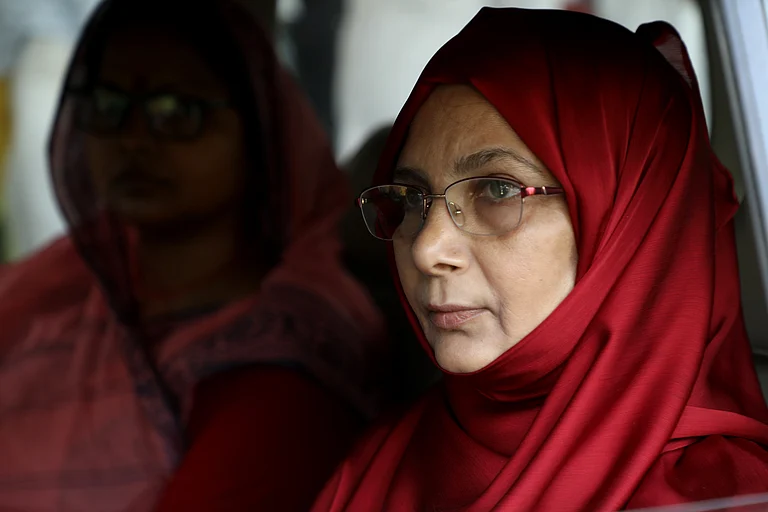The Samastipur Lok Sabha constituency in Bihar has been drawing attention for an unusual electoral race, between the daughter and the son of two Janata Dal (United) (JDU) leaders and ministers in the Nitish Kumar government. Shambhavi Choudhary, daughter of Rural Works Minister Ashok Choudhary, is a National Democratic Alliance (NDA) candidate, who is contesting the election on a Lok Jan Shakti Party (Ram Vilas) (LJP) ticket. Sunny Hazari, son of Information and Public Relation Minister Maheswar Hazari, represents the Congress and the INDIA bloc.
For Chaudhary, however, a more discussion-worthy aspect of the contest is the fact that, at 25, she is the youngest Dalit woman candidate in the country. In two notable developments that took place last year, the Bihar government released the findings of the Caste Survey, and the Parliament passed a 33 per cent Women's Reservation Bill. Although the latter is yet to take the form of law, all political parties have been vocal about giving representation to women. So how do political parties in the state fare when it comes to walking the talk? Have they handed out tickets to women in keeping with their share in the population and the percentage of reservation accorded to them?
Choudhary says that she had hoped that the women's reservation bill would result in many more women contesting elections from all the different parties, but that this has not happened. “You can see how few women there are in the fray even after the passing of the bill. You can also see that there is a 50 per cent reservation for women in Bihar’s Panchayats, for the posts of Panchayat heads, Panchayat members, and Ward members, so it is a puzzle why they don’t get more representation in the Parliament and the Assembly. The stakeholder parties ought to explain this. Do they not like female candidates? Do they think that women cannot win elections? They really need to come clean on this,” she tells Outlook.
Not a single woman from the BJP and the Congress
Choudhary is a first-time contender. Her party, the LJP, has put up women candidates on two of the five seats it is contesting. That amounts to a 40 per cent share in ticket distribution. But the NDA's major ally and the country's largest party, the Bharatiya Janata Party (BJP), which is also incumbent at the Centre, has not fielded a single woman candidate on the 17 Lok Sabha seats it is contesting in the state. Nitish Kumar's JDU fares only marginally better with two women among its 16 candidates. In sum, the NDA has fielded only four female candidates in the 40 seats of Bihar. This amounts to a measly 10 per cent.
Choudhary is saddened by the BJP’s failure in this regard, but she also believes that the overall participation of women has already increased and will increase further in the future.
The Rashtriya Janata Dal (RJD), which is part of the INDIA bloc, has put up six female candidates on the 23 seats it is contesting, placing it at the forefront as a party when it comes to giving tickets to women, not only in the current elections but across several general elections held in recent times. In contrast, there are zero female faces in the 9 seats held by RJD's ally and the country's oldest party, the Congress. This is also the case with the Left parties. The total number of female candidates fielded by INDIA thus amounts to 15 per cent.
To reiterate, the two largest national parties of the country, between them, have not fielded a single woman candidate in Bihar. The apathy appears all the more stark when viewed against the fact that voting by women went up by 10 per cent over the last two general elections. Moreover, in the last general elections, women also outvoted men in as many as 32 Lok Sabha seats of Bihar.
BJP and Congress have uninspiring records even in battleground states
As the country approaches the last stage of the general elections, the political temperature is running high. With a massive total of 210 Lok Sabha seats among them, Uttar Pradesh (UP), Maharashtra, West Bengal, and Bihar are dubbed battleground states. The regional parties in these states have bettered their track records when it comes to giving tickets to women, but the actions of the BJP and the Congress have been highly incongruous with their promises and pronouncements.
UP is the largest state in the country with 80 seats. Here, INDIA members Samajwadi Party and Congress are contesting the elections as partners, with the former putting up candidates on 63 seats and the latter on 17 seats. The percentages of their women candidates are 12.6 per cent (8 contestants) and 5.8 per cent (1 contestant) respectively. Similarly, in the NDA, the BJP has only 6 women among its 75 candidates (8 per cent). The Bahujan Samaj Party, which is going it alone on all the 80 seats, has put up only three women candidates (3.7 per cent).
In Maharashtra, the INDIA constituent parties collectively have 16.6 per cent women in the 48 seats they are contesting: four out of 17 by the Congress, three out of 21 by the Shiv Sena (Uddhav Balasaheb Thackeray), and one woman by the Nationalist Congress Party (Sharadchandra Pawar). Across the aisle, in the NDA, the BJP has 6 female candidates out of its share of 28 seats, Eknath Shinde's Shiv Sena has two, and the Nationalist Congress Party (Ajit Pawar Faction) has one. That amounts to 18 per cent female representation in ticket distribution.
Over in West Bengal, the Trinamool Congress is foremost in fielding women candidates. Out of the 42 seats here, 12 (28 per cent) are being contested for the party by women. In comparison, only seven of the BJP’s candidates on these 42 seats are women (16.6 per cent). The Congress, allied with the Left, has fielded a lone woman candidate out of its 12 seats (8.3 per cent).
Congress leader Priyanka Gandhi's slogan “I am a girl, I can fight” has been much discussed. It kickstarted a campaign which saw the party put up 40 per cent women candidates in the 2021 Assembly elections of UP. In recent months, Rahul Gandhi has stressed on the principle of participation as per population. When asked why we do not see these slogans and promises translating on the ground in these general elections, Sadaf Jafar, National Coordinator of All India Mahila Congress, tells Outlook, “Women's representation is less because right now, the Constitution is in danger and it has to be saved. Ousting Modi is a priority for us. We got less seats in UP and Bihar, so we could not give tickets to many women. We have given tickets to women where they are strong. We have women fighting elections for the Congress in Assam and Tamil Nadu. The tickets have been distributed keeping the winnability of the candidate in mind.”
In a first, Jharkhand gives preference to women
In UP and Bihar, the Congress is contesting the elections on 26 seats, and has fielded only one woman candidate. But in Jharkhand it has two women candidates out of its total of seven. The argument that fewer seats compel it to have fewer women candidates does not seem consistent. For the first time in Jharkhand, all the parties of the INDIA bloc have fielded women candidates. Apart from the Congress’ two, the Jharkhand Mukti Morcha and the RJD have one female candidate each. For the first time, five women candidates of the INDIA or the Grand Alliance are in the fray in the state that has 14 Lok Sabha seats. That is a 35.7 per cent representation. For comparison, the BJP has three women in the 13 seats it is contesting, amounting to 23.07 per cent representation.
It is a novel phenomenon for the state to lead in the number of female candidates in the Lok Sabha elections. Neha Kaur, Assistant Professor at Ranchi Women's College, is cautious in drawing hope. She finds that while there has been a shift in the thinking of Jharkhand’s political parties regarding women, female representation in the legislature is still a matter of concern. Talking to Outlook, Kaur says, “The number of women candidates in elections has gone up in the last few decades, but the question regarding women leaders in the Assembly still remains the same. I believe that it will be tackled only when the number of women in elections increases much more.”
Kaur questions political parties’ failure to allow more women to participate in elections, despite all their rhetoric and the awareness generated. She talks about the naysaying gendered mindset that pervades all areas of life but is particularly visible in politics, which holds that women cannot do this or that, that they are overly emotional and soft, and that they cannot take tough decisions.
Compared to the 2019 general elections, the number of women candidates has increased by a mere 0.5 per cent this time. Against the 720 women candidates earlier, there are 797 this time around.
According to Election Commission data, there were 45 women candidates in the general elections held in 1957. There has been a growth from 4.5 per cent to 9.5 per cent over a period of 67 years.
(Translated by Kaushika Dravid)



















